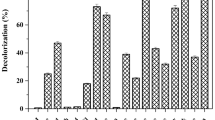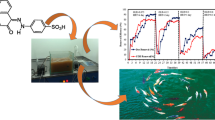Abstract
Considerable researches on removal of azo dyes have been reported in recent years, but few researchers have documented adsorption and/or transformation of anthraquinone dyes by physical, chemical, or biological treatment methods due to their fused aromatic structures. In this study, tea residue was found to have significant enhancement effect on the decolorization of anthraquinone dye reactive blue 19. This effect worked on different dye decolorizing bacterial florae and the natural bacterial flora from surface water and exhibited universal feature. Six single bacterial strains were isolated from bacterial flora DDMY2. Unexpectedly, all of them had poor decolorization capacity. High-throughput sequencing results revealed the community evolution of bacterial flora DDMY2 cultured with tea residue after 6 months and 12 months. It was found that the community structure changed dramatically because the influence of tea residue and the dominant functional genera, such as unclassified_o_Pseudomonadales, Stenotrophomonas, Bordetella, and Brevibacillus, was significantly enriched. Meanwhile, the evolved community structure could keep stable for a long time, resulting in the decolorization effect stabilized for a long time. This study provides the tea residue as the bioactivator that can be applied to boost the decolorization of dyes by various potential bacterial florae. It also enlarges our knowledge of making full use of biowaste in biological wastewater treatment.







Similar content being viewed by others
References
Abu Talha, M., Goswami, M., Giri, B. S., Sharma, A., Rai, B. N., & Singh, R. S. (2018). Bioremediation of Congo red dye in immobilized batch and continuous packed bed bioreactor by Brevibacillus parabrevis using coconut shell biochar. Bioresource Technology, 252, 37–43.
Ali, A., Bilal, M., Khan, R., Farooq, R., & Siddique, M. (2018). Ultrasound-assisted adsorption of phenol from aqueous solution by using spent black tea leaves. Environmental Science and Pollution Research, 25, 22920–22930.
Almeida, E. J. R., & Corso, C. R. (2019). Decolorization and removal of toxicity of textile azo dyes using fungal biomass pelletized. International journal of Environmental Science and Technology, 16, 1319–1328.
Barsing, P., Tiwari, A., Joshi, T., & Garg, S. (2011). Application of a novel bacterial consortium for mineralization of sulphonated aromatic amines. Bioresource Technology, 102, 765–771.
Cao, J., Sanganyado, E., Liu, W., Zhang, W., & Liu, Y. (2019). Decolorization and detoxification of Direct Blue 2B by indigenous bacterial consortium. Journal of Environmental Management, 242, 229–237.
Chaudhari, A. U., Paul, D., Dhotre, D., & Kodam, K. M. (2017). Effective biotransformation and detoxification of anthraquinone dye reactive blue 4 by using aerobic bacterial granules. Water Research, 122, 603–613.
Chen, C.-Y., Tsai, T.-H., Wu, P.-S., Tsao, S.-E., Huang, Y.-S., & Chung, Y.-C. (2018). Selection of electrogenic bacteria for microbial fuel cell in removing Victoria blue R from wastewater. Journal of Environmental Science and Health Part A-Toxic/Hazardous Substances & Environmental Engineering, 53, 108–115.
Cheng, N., Li, Q., Tang, A., Su, W., & Liu, Y. (2018). Decolorization of a variety of dyes by Aspergillus flavus A5p1. Bioprocess and Biosystems Engineering, 41, 511–518.
Cui, M.-H., Cui, D., Liang, B., Sangeetha, T., Wang, A.-J., & Cheng, H.-Y. (2016). Decolorization enhancement by optimizing azo dye loading rate in an anaerobic reactor. RSC Advances, 6, 49995–50001.
Cui, D., Shen, D., Wu, C., Li, C., Leng, D., & Zhao, M. (2017). Biodegradation of aniline by a novel bacterial mixed culture AC. International Biodeterioration & Biodegradation, 125, 86–96.
Deniz, F., & Yildiz, H. (2019). Bioremediation potential of a widespread industrial biowaste as renewable and sustainable biosorbent for synthetic dye pollution. International Journal of Phytoremediation, 21, 259–267.
Haq, I., Raj, A., & Markandeya. (2018). Biodegradation of Azure-B dye by Serratia liquefaciens and its validation by phytotoxicity, genotoxicity and cytotoxicity studies. Chemosphere, 196, 58–68.
Holkar, C. R., Pandit, A. B., & Pinjari, D. V. (2014). Kinetics of biological decolorisation of anthraquinone based Reactive Blue 19 using an isolated strain of Enterobacter sp. F NCIM 5545. Bioresource Technology, 173, 342–351.
Hou, L., Li, X., Yang, Q., Chen, F., Wang, S., Ma, Y., et al. (2019). Heterogeneous activation of peroxymonosulfate using Mn-Fe layered double hydroxide: Performance and mechanism for organic pollutant degradation. Science of the Total Environment, 663, 453–464.
Kumari, L., Tiwary, D., & Mishra, P. K. (2016). Biodegradation of C.I. Acid Red 1 by indigenous bacteria Stenotrophomonas sp. BHUSSp X2 isolated from dye contaminated soil. Environmental Science and Pollution Research, 23, 4054–4062.
Li, P., Chen, X., Zeng, X., Zeng, Y., Xie, Y., Li, X., et al. (2018). Utilization of waste biomass (kitchen waste) hydrolysis residue as adsorbent for dye removal: Kinetic, equilibrium, and thermodynamic studies. Applied Biochemistry and Biotechnology, 185, 971–985.
Lu, X.-M., Ma, L.-H., Wang, Z.-H., & Huang, M.-S. (2010). Application of polymerase chain reaction-denaturing gradient gel electrophoresis to resolve taxonomic diversity in white rot fungus reactors. Environmental Engineering Science, 27, 493–503.
Mahmood, Q., Masood, F., Bhatti, Z. A., Siddique, M., Bilal, M., Yaqoob, H., et al. (2014). Biological treatment of the dye Reactive Blue 19 by cattails and anaerobic bacterial consortia. Toxicological and Environmental Chemistry, 96, 530–541.
Naraghi, B., Zabihi, F., Narooie, M. R., Saeidi, M., & Biglari, H. (2017). Removal of Acid Orange 7 dye from aqueous solutions by adsorption onto Kenya tea pulps; granulated shape. Electronic Physician, 9, 4312–4321.
Naz, I., Sadaf, S., Iqbal, J., Ullah, I., & Nawaz, F. (2018). Efficient utilization of bio-energy process residue for removal of Drimarine Yellow HF-3GL dye from aqueous solution. Desalination and Water Treatment, 102, 326–339.
Pan, F., Yu, Y., Xu, A., Xia, D., Sun, Y., Cai, Z., et al. (2017a). Application of magnetic OMS-2 in sequencing batch reactor for treating dye wastewater as a modulator of microbial community. Journal of Hazardous Materials, 340, 36–46.
Pan, H., Xu, X., Wen, Z., Kang, Y., Wang, X., Ren, Y., et al. (2017b). Decolorization pathways of anthraquinone dye Disperse Blue 2BLN by Aspergillus sp. XJ-2 CGMCC12963. Bioengineered, 8, 630–641.
Patil, C. S., Gunjal, D. B., Naik, V. M., Harale, N. S., Jagadale, S. D., Kadam, A. N., et al. (2019). Waste tea residue as a low cost adsorbent for removal of hydralazine hydrochloride pharmaceutical pollutant from aqueous media: An environmental remediation. Journal of Cleaner Production, 206, 407–418.
Pavlovic, M. D., Nikolic, I. R., Milutinovic, M. D., Dimitrijevic-Brankovic, S. I., Siler-Marinkovic, S. S., & Antonovic, D. G. (2015). Plant waste materials from restaurants as the adsorbents for dyes. Hemijska Industrija, 69, 667–677.
Piaskowski, K., Swiderska-Dabrowska, R., & Zarzycki, P. K. (2018). Dye removal from water and wastewater using various physical, chemical, and biological processes. Journal of AOAC International, 101, 1371–1384.
Qi, M., Huang, H., Zhang, Y., Wang, H., Li, H., & Lu, Z. (2019). Novel tetrahydrofuran (THF) degradation-associated genes and cooperation patterns of a THF-degrading microbial community as revealed by metagenomic. Chemosphere, 231, 173–183.
Saba, B., Christy, A. D., Park, T., Yu, Z., Li, K., & Tuovinen, O. H. (2018). Decolorization of Reactive Black 5 and Reactive Blue 4 dyes in microbial fuel cells. Applied Biochemistry and Biotechnology, 186, 1017–1033.
Sekuljica, N. Z., Prlainovic, N. Z., Stefanovic, A. B., Zuza, M. G., Cickaric, D. Z., Mijin, D. Z., et al. (2015). Decolorization of anthraquinonic dyes from textile effluent using horseradish peroxidase: optimization and kinetic study. The Scientific World Journal, 2015, 371625–371625.
Shyla, H., Saha, P., & Rao, K. V. B. (2018). Biodegradation and decolorization of two different azo dyes, Reactive Blue 221 and Direct Black 38, and assessment of the degraded dye metabolites. Desalination and Water Treatment, 123, 338–347.
Tang, L., Xiao, F., Wei, Q., Liu, Y., Zou, Y., Liu, J., et al. (2019). Removal of active dyes by ultrafiltration membrane pre-deposited with a PSFM coagulant: Performance and mechanism. Chemosphere, 223, 204–210.
Vikrant, K., Giri, B. S., Raza, N., Roy, K., Kim, K.-H., Rai, B. N., et al. (2018). Recent advancements in bioremediation of dye: Current status and challenges. Bioresource Technology, 253, 355–367.
Wang, W.-L., Cai, Y.-Z., Hu, H.-Y., Chen, J., Wang, J., Xue, G., et al. (2019). Advanced treatment of bio-treated dyeing and finishing wastewater using ozone-biological activated carbon: A study on the synergistic effects. Chemical Engineering Journal, 359, 168–175.
Xie, X., Fu, J., Wang, H., & Liu, J. (2010). Heavy metal resistance by two bacteria strains isolated from a copper mine tailing in China. African Journal of Biotechnology, 9, 4056–4066.
Xie, X., Liu, N., Yang, B., Yu, C., Zhang, Q., Zheng, X., et al. (2016). Comparison of microbial community in hydrolysis acidification reactor depending on different structure dyes by Illumina MiSeq sequencing. International Biodeterioration & Biodegradation, 111, 14–21.
Xie, X., Liu, N., Ping, J., Zhang, Q., Zheng, X., & Liu, J. (2018a). Illumina MiSeq sequencing reveals microbial community in HA process for dyeing wastewater treatment fed with different co-substrates. Chemosphere, 201, 578–585.
Xie, X., Liu, N., Yang, F., Zhang, Q., Zheng, X., Wang, Y., et al. (2018b). Comparative study of antiestrogenic activity of two dyes after Fenton oxidation and biological degradation. Ecotoxicology and Environmental Safety, 164, 416–424.
Xie, X., Zheng, X., Yu, C., Zhang, Q., Wang, Y., Cong, J., et al. (2019). Highly efficient biodegradation of reactive blue 19 under the activation of tea residue by a newly screened mixed bacterial flora DDMY2. RSC Advances, 9, 24791–24801.
Xu, X., Zheng, Y., Gao, B., & Cao, X. (2019). N-doped biochar synthesized by a facile ball-milling method for enhanced sorption of CO2 and reactive red. Chemical Engineering Journal, 368, 564–572.
Yang, Q., Wang, J., Wang, H., Chen, X., Ren, S., Li, X., et al. (2012). Evolution of the microbial community in a full-scale printing and dyeing wastewater treatment system. Bioresource Technology, 117, 155–163.
Yang, Q., Wang, J., Han, X., Xu, Y., Liu, D., Hao, H., et al. (2014). Analysis of the bacterial community in a full-scale printing and dyeing wastewater treatment system based on T-RFLP and 454 pyrosequencing. Biotechnology and Bioprocess Engineering, 19, 191–200.
Yu, C., Xie, X., Zheng, X., Xu, L., Li, R., & Liu, J. (2016). Decolorization and repigmentation of reactive black 5 biodegradation and their mechanisms. Chemical Industry and Engineering Progress, 35, 2987–2996.
Yuan, S., Zhang, N., Wu, X., Qian, Y., Chen, X., Raza, W., et al. (2017). Effect of pruned material, extracts, and polyphenols of tea on enzyme activities and microbial community structure in soil. Soil Science and Plant Nutrition, 63, 607–615.
Zhang, Q., Xie, X., Yu, C., Chen, Y., & Liu, J. (2017). Effects of different co-metabolic substrates on the decolorization of reactive black 5 by bacteria and the community structure of bacterial flora. Chinese Journal of Ecology, 36, 2572–2580.
Zhang, Q., Xie, X., Liu, Y., Zheng, X., Wang, Y., Cong, J., et al. (2019). Fructose as an additional co-metabolite promotes refractory dye degradation: Performance and mechanism. Bioresource Technology, 280, 430–440.
Zheng, X., Xie, X., Yu, C., Zhang, Q., Wang, Y., Cong, J., et al. (2019). Unveiling the activating mechanism of tea residue for boosting the biological decolorization performance of refractory dye. Chemosphere, 233, 110–119.
Zhou, J. Z., Bruns, M. A., & Tiedje, J. M. (1996). DNA recovery from soils of diverse composition. Applied and Environmental Microbiology, 62, 316–322.
Funding
The authors acknowledge the financial support by the Fundamental Research Funds for the Central Universities (2232018G-11, 2232019D3-22), the National Key Research and Development Program of China (Grant No. 2016YFC0400501), the Graduate Student Innovation Fund of Donghua University (CUSF-DH-D-2019078), Anhui Provincial Natural Science Foundation (1808085QE176), the scientific research program of Anhui Provincial Education Department (KJ2018A0444) and the Suzhou University Startup Foundation for Doctor (2016jb04), the “Chenguang Program” supported by Shanghai Education Development Foundation and Shanghai Municipal Education Commission (No. 16CG40). This work was partially supported by Shanghai Leading Academic Discipline Project (B604).
Author information
Authors and Affiliations
Corresponding authors
Ethics declarations
Conflict of Interest
The authors declare that they have no conflict of interest.
Additional information
Publisher’s Note
Springer Nature remains neutral with regard to jurisdictional claims in published maps and institutional affiliations.
Electronic supplementary material
ESM 1
(DOCX 71 kb)
Rights and permissions
About this article
Cite this article
Xie, X., Zheng, X., Yu, C. et al. Tea Residue Boosts Dye Decolorization and Induces the Evolution of Bacterial Community. Water Air Soil Pollut 230, 261 (2019). https://doi.org/10.1007/s11270-019-4307-6
Received:
Accepted:
Published:
DOI: https://doi.org/10.1007/s11270-019-4307-6




